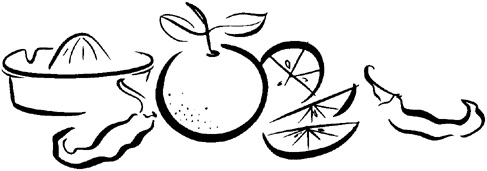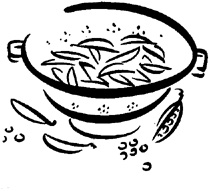
SERVES 3 TO 4 AS A MAIN COURSE, 5 TO 6 AS PART OF A MULTICOURSE MEAL
Drop all thoughts of the saccharin-sweet, deep-fried orange beef that is a fixture in Hunanese-American restaurants! This is a light-style, gustily seasoned stir-fry embellished with fresh orange zest and just enough sugar to bring forth the heat.

I was lucky enough to be in the hands of a culinary adventurer when I was first learning how to eat in China. This was the old Yangchow man whom I called Po-fu (“uncle”) and with whom I lived in Taiwan as a student. His first question to me at the dinner table was on the subject of Russian dressing, about which he’d heard from a Shanghai friend. (If Yangchow people were epicures, Shanghai people were indefatigable experimenters in international cuisine.) As a response, I snuck down to the U.S. Army PX the next day after school, bought some ketchup and mayonnaise, and whipped up a batch of the stuff. A friendship was born, though the mess went uneaten.
After a year of extraordinary tutelage in the hands of Po-fu, it lamentably came time for me to leave the island. Po-fu had heard of the recent opening of a Japanese nightclub featuring something called a “han-bow” (the Mandarin approximation of hamburger) and insisted we try one as a salute to my departure. Everyone got dressed up. This kind of culinary excursion was Serious Business. We hired a spiffy cab, rolled up in front of the jazzily dressed doorman, and went in like the Imperial family on parade. Po-fu strutted jauntily in the lead, his eyes shining brightly at the prospect of something new to eat. The han-bow was tasted, eyed quizzically, and pushed aside with a single disdaining finger. We left with all the pomp with which we’d arrived, Po-fu rapping the doorman with his cane. Once home, he cooked up a big bowl of noodles and insisted we all eat.
We both cried bitterly at the airport when I left. Surely the old man imagined he was sending me off to starve in a strange world of Russian dressing and han-bows, never again to know the redemption of wholesome Chinese food. Is it any wonder I adored him?
The beef will be tastiest if marinated overnight, but if you are in a hurry, the time can be cut short and the dish made in under an hour.
¾ pound trimmed flank steak, all fat and tough sinew removed
MARINADE:
1 tablespoon soy sauce
1 tablespoon mushroom soy sauce
1 tablespoon cornstarch
1 tablespoon packed brown sugar
1 tablespoon China Moon Chili-Orange Oil (page 15)
1 tablespoon “goop” from China Moon Chili-Orange Oil
AROMATICS:
2 tablespoons finely minced fresh ginger
1 tablespoon finely minced garlic
2 tablespoons thinly sliced green and white scallion rings
1 red Fresno chili, finely minced
Finely minced zest of 1 scrubbed orange
SAUCE:
1½ cups China Moon Infusion (page 72), China Moon Double Stock (page 72), or unsalted chicken stock
2 tablespoons mushroom soy sauce
¼ cup freshly squeezed orange juice
2 tablespoons balsamic vinegar
¾ to 1½ teaspoons sugar
½ cup fresh peas, or 1 cup tipped and strung sugar snap peas or roll-cut (page 260) asparagus nuggets
2 to 3 cups corn or peanut oil, for velveting and stir-frying
1 small red onion, cut into ¾-inch squares
1 small red bell pepper, cut into ¾-inch squares
½ small bulb fennel, cut crosswise into ⅛-inch arcs
4 to 6 Italian field or other wild mushrooms, cut into thick slices
2 fat scallions, cut into 1-inch nuggets
1 cup small clusters of oyster mushrooms
1 tablespoon cornstarch dissolved in 1½ tablespoons cold stock or water
1 cup loosely packed baby spinach leaves or thick ribbons of ruby chard
Green and white scallion julienne, for garnish

1. Cut the meat lengthwise (with the grain) into several strips about 2 inches wide. Holding your knife at an angle to the board, cut each strip crosswise into ribbons ⅛ inch thick.
2. Blend the marinade ingredients until smooth in a bowl big enough to hold the beef. Add the beef and toss to coat each slice. Seal and set aside to marinate at cool room temperature for 3 to 4 hours, or refrigerate overnight. Let the beef come to room temperature before cooking; re-toss to separate the shreds.
3. Combine the aromatics in a small dish and cover until ready to use.
4. Combine all of the sauce ingredients through the sugar in a small bowl. Stir to blend, leaving the spoon in the bowl.

5. In a small saucepan filled with rapidly boiling water, blanch the peas until tender-crisp, 10 to 30 seconds. Immerse in ice water to chill; drain well. If using sugar snap peas or asparagus, blanch them until tender-crisp, 20 to 60 seconds depending on thickness; refresh in ice water and drain. To this point, all the above, including the vegetable cutting, may be done a day ahead. Seal and refrigerate the ingredients; bring to room temperature before cooking.
6. About 20 minutes before serving, velvet the beef following step 6 on page 259.
7. Return the pan to high heat. When the oil is hot enough to sizzle a scallion ring, reduce the heat to moderate and add the aromatics. Stir gently until fully fragrant, 20 to 30 seconds, adjusting the heat so they foam without browning. Add the onion and bell pepper, and toss briskly until slightly softened, 2 to 3 minutes. Add the fennel and toss until the fennel is half-cooked, another 2 to 3 minutes. Add the field mushrooms and scallions, and toss for 1 minute. Add the oyster mushrooms and toss for 1 minute more. Adjust the heat to maintain a merry sizzle and drizzle a bit more oil down the side of the pan, if needed to prevent sticking. Don’t worry if the vegetables brown a bit; they will be tasty. If you are using chard, add it now and toss to combine.
8. Stir the sauce and add it to the pan. Raise the heat, cover the pan, and bring the sauce to a simmer. When the sauce simmers, stir to recombine the cornstarch mixture, add it to the pan, and stir the sauce until it turns glossy and slightly thick, 10 to 20 seconds. Add the spinach, peas, and beef, and toss gently until the spinach wilts and the beef is cooked through, 10 to 15 seconds.

In cooking classes around the country, I regularly “treat” my students to a taste-test of three skillet-melted fresh fats: pork, lamb, and beef. It is astounding to them to discover that while the taste of pork fat is pleasant, neutral, and light, the flavors of beef and lamb fat are comparatively overwhelming and heavy. Unlike the pork fat, both beef and lamb fat coat the tongue and leave a strong aftertaste. This is amazing news for those who have grown up to think of pork as a “heavy” meat, and lamb or beef as the lighter choice.
One would think that this would inspire a Chinese cook to buy leaner cuts of beef and lamb, but not so! A Chinese cook will not buy a leaner cut of meat when internal fat in the muscle means better flavor and better texture. A Chinese cook will instead alter the character of beef and lamb fat by pairing the meat with the astringent flavors of ginger, scallion, wine, and citrus zest. I am not a health expert, but my suspicion is that these acids succeed in breaking down the fats and making the meats more digestible, in addition to rendering them more tasty.
9. Serve immediately on heated plates of contrasting color. Garnish with a sprinkling of the scallion julienne on top.
MENU SUGGESTIONS: We usually serve the beef as a topping for a Pot-Browned Noodle Pillow (page 401). If you are a pasta fan, you could also use a Broad Noodle Pillow (page 403) or simply cooked fettuccine. Rice would be equally good, as would Wok-Seared New Potatoes (page 424) or a dish of great mashed potatoes. A watercress salad or ears of freshly cooked corn would partner the beef perfectly if you would like to serve another dish.